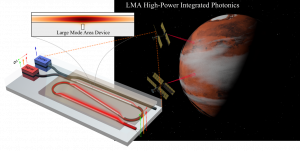Tunable laser with sub-2 Watts of optical power from a silicon photonics device
GA, UNITED STATES, January 7, 2025 /EINPresswire.com/ -- High output power signal with high quality is needed for various applications today ranging from telecom to optical sensing. Such high-power systems aren’t usually associated with integrated photonics (which helps miniaturize the system, but at the cost of severe reduction in signal power). Scientist in Germany have overcome this challenge and have demonstrated very high-power tunable laser in silicon photonics with output power reaching ~2 Watts.
In today's world the size of various systems, which are accommodating evermore smaller components, is continuously decreasing, for applications such as, high-speed data centers and space exploration with small-scale satellites. However, such miniaturization and high-density integration, enabled by integrated photonics, has severely undermined the signal power generation capability of such systems. Traditionally, high-power is considered to be in the realms of meter-scale systems such as fiber and solid-state systems as their large volume allow for large energy storage capacity. In the micron to millimeter scale systems, such as the ones based on integrated photonics, optical energy storage capacity is a far cry from that of the benchtop systems, hence the power generation capability remains significantly lower in integrated photonics.
In order to achieve large scale deployment of highly functional, mass producible silicon photonics systems and replace bulky benchtop system, it is imperative that silicon photonics based lasers and amplifiers generate high power signal at a level comparable to benchtop systems.
Recently, researchers in Germany, led by Dr. Neetesh Singh and Prof. Franz Kärtner, have demonstrated a very high-power tunable laser reaching close to 2 Watts of output power, thanks to the recently conceived large-mode-area (LMA) integrated waveguide amplifier on silicon photonics.
The researchers envisage that such a device can have a disruptive impact in the field of photonics, and may allow integrated photonics devices to be implemented at a large scale across various fields.
A potential application could be that, such a high-power tunable laser operating at long wavelength window is deployed in small-scale satellites to sense and map out ( with technologies such as LIDAR), molecules essential for life in the outerspace; for example, carbon dioxide, water and ammonia. The high power tunable lased based on LMA silicon photonics will reduce the system size, weight and cost by several orders of magnitude compared to the conventional fiber or solid state-based systems allowing multiple cost-effective space missions with highly enhanced capabilities not possible before.
DOI
10.1038/s41377-024-01681-1
Original Source URL
https://doi.org/10.1038/s41377-024-01681-1
Funding information
This work is supported by EU Horizon 2020 Framework Programme - Grant Agreement No.: 965124 (FEMTOCHIP), and Deutsche Forschungsgemeinschaft (SP2111) contract number PACE:Ka908/10-1
Lucy Wang
BioDesign Research
email us here
Legal Disclaimer:
EIN Presswire provides this news content "as is" without warranty of any kind. We do not accept any responsibility or liability for the accuracy, content, images, videos, licenses, completeness, legality, or reliability of the information contained in this article. If you have any complaints or copyright issues related to this article, kindly contact the author above.

